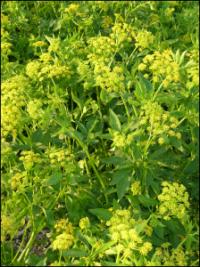Description
Tiny chartreuse-golden flowers, grouped in umbels, spring. Good cut flower.
In spring, golden umbels
Tiny chartreuse-golden flowers, grouped in umbels, spring. Good cut flower.
OUT OF STOCK
Rosettes of succulent leaves
Size: 4” x 4”
Care: sun in well-drained to moist well-drained soil
Native: Alps & Pyrenees Mountains
Grown in gardens for thousands of years. Sempervivum means “live forever.” Romans planted Hens and chicks on their roofs to ward off lightening. As a succulent it holds water and is probably more difficult to catch fire. “This practice was preserved for historians when Charlemagne (720-814), first Holy Roman Emperor and unifier of a large part of northern Europe, ordered that all villagers within his crown lands plant houseleeks on their roofs He decreed: “Et ille hortulanus habeat super domum suam Iovis barbam. (And the gardener shall have house-leeks growing on his house. Capitulare de villis, about 795, LXX.)”
Profusion of small classic daisies May-July atop fragrant silver foliage. Cut back for rebloom. Let the seeds drop for more plants next year. If you cut them back after the 1st flowering they will rebloom for most of the summer and fall.
Size: 2’ x 3’
Care: sun in moist well drained soil
Native: central & southern Europe
Named by Carl Heinrich Schultz (1805-1867)
Dark pink-purple flowers from late spring to mid-summer
Size: 32” x 18”
Care: full sun to part shade in moist well-drained soil
Native: Europe
Wildlife Value: a favorite of Bumblebees
In Greek mythology Silene was a companion of Bacchus who was covered with foam. Dioicus means that male and female plants are separate. Described by 1750’s. Grown in American gardens since 1800’s
Short purple spikes in June-July
Size: 3” x 24”
Care: sun in well-drained soil
Native: Europe & Western Asia
Size: groundcover, rock garden, herb, fragrant foliage, thyme lawn
Thymus from the Greek word for “odor” due to the plant’s fragrance. Ancient Greeks made incense with thyme. This species since at least 1753. Acc’d to Parkinson in 1640 this remedied hysterics in women. Wm. Robinson wrote,”nothing can be more charming than a sunny bank covered with” Thymus serpyllum. LH Bailey extolled it as “prized as an evergreen edging and as cover for rockwork and waste places …The leaves are sometimes used for seasoning.”

